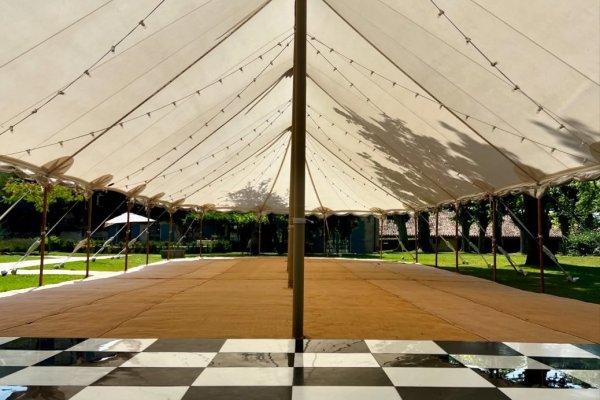How Do You Make A Wedding Budget?
20/11/2023Weddings are notoriously expensive, and if you're not careful, it's easy to blow your entire budget on just the venue and catering. Weddings cost upwards of £17,000 in the UK, so these one-day events are enormous financial commitments.
Thus, it's essential to sit down with your partner and create a realistic wedding budget that will keep your spending in check and help you avoid going into debt.
With that in mind, here's a step-by-step guide to creating a wedding budget.
1. Figure Out How Much You Can Realistically Afford to Spend
The first step is to take a long, hard look at your finances and figure out how much you can realistically afford to spend on your wedding. This number will differ for everyone, so there's no right or wrong answer.
Be honest with yourselves and each other about what you can afford to spend without going into debt, and be realistic about what you can save between now and your wedding date. Take the ego out of the equation and ask yourselves what is truly important to you and your partner.
Remember, in most cases, a wedding lasts less than 24 hours. Yes, it's an incredibly important life event, but it's not worth going into debt for, especially if you're spending more than you should impress other people.
Don't forget to include all sources of money going into the wedding "pot", including any promised contributions from either set of parents. As a general rule, you need to have at least 25% of your total wedding budget on hand in cash at all times, so you can put down deposits as and when needed to secure your venue and other critical wedding suppliers.
2. Slash Your Budget By At Least 10%
It might seem odd to get a budget together and then immediately trim it down. But without a robust contingency fund, you might not have the money to cover unexpected costs (and there will always be unexpected costs).
Therefore, as soon as you have decided on your budget, immediately slash it by at least 10% (15% if you want to be extra cautious). This will give you a nice buffer in case anything goes wrong, and it will also help to keep your spending in check.
3. Allocate Roughly Half of Your Remaining Budget to the Venue
With your reworked budget in hand, it's time to start allocating your spending. The first and arguably most important item on your list should be the venue and its related costs, accounting for roughly half of your wedding budget.
To be clear, the costs covered in this category include the hire fee for the venue itself, any furniture or décor you need to rent, and the cost of food and drink (if you're not doing a DIY catering option).
As many venues will quote food and drink on a per-head basis, this is the time to start working out and whittling down your guest list. While you don't have to make any final or binding decisions just yet, it's good to have a general idea of how many people you'll be inviting so that you can get accurate quotes from potential venues and ensure you're not spending more than you need to.
Although bear in mind that plenty of venue extras, such as accommodation, corkage, service charges, and other incidentals, are often not included on a per-head basis. So even if a venue looks affordable when you first see their pricing, make sure you ask about all the potential extras and factor them into your budget.
4. Decide Your Priorities for the Remainder of Your Wedding Budget
The remaining 50% of your reworked budget will cover everything else related to your wedding, from the dress and flowers to the photographer and transportation. This is where you will have to decide what's most important to you and your partner.
For example, if you're set on having a designer wedding dress but are happy with some simple floral arrangements, then you know where to allocate a more significant chunk of your remaining budget. Conversely, if you've found a live wedding band that you absolutely love but are happy with a more low-key photographer, then you'll need to adjust your budget accordingly.
The key is to be realistic about what you can afford within the parameters of your agreed-upon wedding budget, what you're willing to splurge on, and what you're happy to compromise on.
5. Ensure You're Getting Good Value for Money
Now that you've got a handle on your wedding budget and have started allocating your spending, it's time to start booking your suppliers.
When making your way through your wedding suppliers, getting multiple quotes for each service and item is vital. Not only will this help you to compare prices and ensure you're getting good value for money, but it will also give you some negotiating power when it comes to haggling for discounts.
In addition, always request a breakdown of costs so you can see where your money is going and ensure that you're not being charged for anything unexpected. Remember, suppliers will often add VAT, travel, delivery, setup, and service fees to their totals, which can quickly add up and eat into your budget. So make sure there aren't any hidden charges lurking in the small print.
Finally, keep all your receipts and any contracts signed in a safe place so you can reference them later if needed. It will give you peace of mind and help to avoid any nasty surprises further down the line.
6. Keep On Top of Your Budget Throughout the Planning Process
Once you start spending money through deposits, fees, and other upfront costs, getting complacent and letting your budget slide can be easy. However, this is a surefire way to end up overspending and putting unnecessary stress on yourself in the lead-up to your big day.
It's important to remain resolute during this crucial phase. Stick to your agreements about what you're going to compromise on, and if you're not saving as much as you'd planned, you need to address this head-on. There's no shame in admitting that you need to cut back elsewhere or reassess your priorities.
At this point, some couples lose sight of their budget and start making decisions that lead them to borrow money and get into significant debt in some cases. If you find yourself in this situation, taking a step back and reassessing your priorities (step number 4) is essential.
An excellent way to avoid getting into a mess with your budget is by paying your must-have suppliers first, such as the venue, caterers, and photographer, and then stagger in each remaining contractor over the following weeks and months, when you're sure you can afford to do so.
Use software such as Google Sheets or Excel to keep track of all the incomings and outgoings, and whatever you do, do not touch your contingency fund!
7. Make Final Supplier Payments and Enjoy the Build-Up to Your Wedding Day
As the big day draws nearer, it's time to start making final payments to all your suppliers. This is usually just a few weeks before the wedding, although some might request to be paid in full upfront if they're offering minor services such as wedding stationery.
At this stage, you should have a good idea of how much money is left in your wedding budget (if any) and whether or not you'll need to dip into your contingency fund to cover any final costs.
If you do have cash leftover, congratulations! This is a great position to be in, and you can either use the money to add some elements or services that you only previously classed as "nice-to-have" rather than "essential". Alternatively, you could put this money towards your honeymoon fund.
With everyone paid up and your wedding budget hopefully in good shape, it's time to sit back, relax, and enjoy the final few weeks before your big day!











